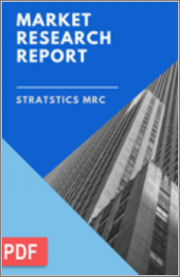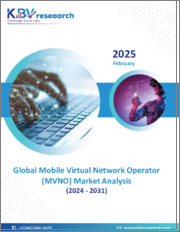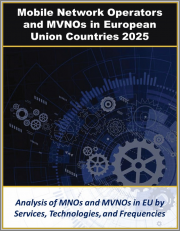
|
시장보고서
상품코드
1359029
IoT 가상이동통신망사업자 시장 예측(-2030년) : 도입별, 운영 모델별, 가입자별, 최종사용자별, 지역별 세계 분석IoT Mobile Virtual Network Operator Market Forecasts to 2030 - Global Analysis By Deployment, Operational Model (Reseller, Service Operator, Full Mobile Virtual Network Operator and Other Operational Models), Subscriber, End User and By Geography |
||||||
Stratistics MRC에 따르면 세계의 IoT 가상이동통신망사업자 시장은 2023년에 664억 달러를 차지하고 예측 기간 중 CAGR은 8.7%로 성장하며, 2030년에는 1,195억 달러에 달할 것으로 예측되고 있습니다.
IoT MVNO는 기존 이동통신사로부터 네트워크 인프라를 빌려 스마트 센서, 웨어러블 기술, 산업용 기계 등 다양한 IoT 기기에 맞는 IoT 연결 서비스를 제공합니다. 비용 효율적이고 확장 가능한 맞춤형 IoT 연결 솔루션을 제공하여 안정적인 데이터 전송을 보장하고 기업이 IoT 데이터를 효율적으로 관리하고 분석하여 업무 효율성과 의사결정을 개선할 수 있도록 하는 것이 장점입니다.
GSMA에 따르면 2025년까지 5G 연결이 8억 700만 건에 달할 것으로 예상되며, 중국은 2025년 세계에서 가장 많은 5G 연결을 차지할 것으로 예상됩니다.
효율적인 셀룰러 네트워크에 대한 수요 증가
IoT 생태계가 빠르게 성장함에 따라 IoT 디바이스의 대량 유입을 지원하는 안정적인 대용량 네트워크에 대한 요구가 증가하고 있으며, MVNO는 IoT 용도을 위해 셀룰러 연결을 최적화하고 조정하여 효율적인 데이터 전송을 보장하고 기존 네트워크의 혼잡을 완화하는 데 중요한 역할을 하고 있습니다. 기존 네트워크의 혼잡을 완화하는 데 중요한 역할을 하고 있습니다. 이러한 IoT 전용 연결 솔루션에 대한 수요는 MVNO 시장의 성장을 가속하고 있으며, 원활하고 확장 가능하며 효율적인 연결 서비스를 제공함으로써 기업과 업계가 IoT 기술의 잠재력을 최대한 활용할 수 있는 기회를 제공합니다.
솔루션의 상호 운용성 부족
다양한 제조업체의 IoT 기기와 플랫폼은 서로 다른 통신 프로토콜과 표준을 사용하는 경우가 많기 때문에 MVNO가 다양한 생태계에서 원활한 연결성을 제공하는 것은 쉽지 않습니다. 이러한 상호운용성 부족은 IoT 솔루션을 도입하려는 기업에게 호환성 문제, 복잡성 증가, 통합 비용 증가로 이어질 수 있습니다. 이는 IoT 도입의 용이성을 저해할 뿐만 아니라 MVNO 서비스의 확장성과 효율성을 제한하고, IoT 보급에 장애가 되어 시장 성장을 제한할 수 있습니다.
모바일 네트워크 가입자 증가 및 모바일 기기 보급 확대
모바일 네트워크에 장비와 시스템을 연결하는 사람과 조직이 늘어남에 따라 MVNO가 제공하는 IoT 연결 서비스에 대한 수요가 급증할 것입니다. 이러한 추세는 MVNO가 고객 기반과 수입원을 확대할 수 있는 길을 열어줍니다. 잠재적 고객층이 확대됨에 따라 MVNO는 의료 및 농업에서 물류 및 스마트 시티에 이르기까지 다양한 산업의 다양한 요구를 충족시키고 전문적이고 신뢰할 수 있으며 비용 효율적인 IoT 연결 솔루션을 제공함으로써 이 기회를 활용할 수 있습니다.
도입 비용 급증
특화된 IoT 네트워크의 구축과 유지보수에는 많은 비용이 소요되며, 특히 IoT 기기의 수가 계속 증가함에 따라 비용이 증가합니다. 이러한 비용에는 인프라 구축, 주파수 대역 라이선스, 지속적인 유지보수 비용 등이 포함되며, MVNO가 이러한 비용 상승을 관리하거나 흡수하지 못하면 고객에 대한 서비스 요금이 상승하여 IoT 연결 솔루션의 비용 효율성이 떨어질 수 있습니다. 가능성이 있습니다. 또한 잠재적 사업자 시장 진입을 막거나 기존 사업자의 서비스 축소로 이어져 시장 성장과 혁신 가능성을 저해할 수 있습니다.
COVID-19의 영향 :
COVID-19는 IoT 가상 이동 통신 사업자(MVNO) 시장에 이중적인 영향을 미쳤습니다. 초기에는 공급망에 혼란이 발생해 IoT 장비와 인프라 도입이 지연되었습니다. 그러나 팬데믹 관련 문제를 해결하기 위해 의료, 원격 모니터링, 공급망 관리 등 다양한 산업에서 IoT 솔루션 도입이 가속화되었습니다. 이에 따라 MVNO 시장에서는 IoT 연결 서비스에 대한 수요가 증가했습니다. 기업이 디지털 혁신과 회복탄력성을 우선시하는 가운데, 이번 팬데믹은 IoT의 중요성을 부각시킴과 동시에 급변하는 시장 환경에서의 민첩성과 적응력을 강조하는 동시에 MVNO에 필수적인 연결 솔루션을 제공할 수 있는 기회를 제공했습니다.
예측 기간 중 제조업 부문이 가장 큰 비중을 차지할 것으로 예상
제조업 부문은 IoT 가상 이동 통신 사업자(MVNO) 시장에서 제조 부문은 산업 부문이 업무 효율성 향상과 자동화를 위해 IoT 연결을 채택하는 것과 관련이 있습니다. 제조 기업은 장비 모니터링, 재고 추적, 생산 공정 최적화, 품질 관리 등을 위해 IoT 기기 및 솔루션을 도입하고 있으며, MVNO는 제조 환경의 고유한 수요에 맞는 전용 저지연 연결을 제공함으로써 중요한 역할을 담당하고 있습니다. 이를 통해 실시간 데이터 교환, 예지보전, 공급망 관리를 개선할 수 있습니다.
예측 기간 중 가장 높은 CAGR이 예상되는 소비자 부문
예측 기간 중 CAGR이 가장 빠르게 성장할 것으로 예상되는 부문은 소비자 부문으로, EV의 사용이 증가함에 따라 EV의 첨단 전자 시스템이 해킹 및 무단 액세스에 노출될 수 있다는 우려가 커지고 있습니다. 전기자동차(EV)를 위한 IoT 가상 이동 통신사 솔루션은 암호화 통신 프로토콜, 실시간 모니터링, 침입 탐지 시스템 등 다양한 방법을 통해 전기자동차(EV)를 보호할 수 있습니다. 이러한 절차는 배터리 관리 시스템 및 자율주행 기능을 포함한 중요한 EV 컴포넌트를 보호하고 EV 생태계의 일반적인 보안과 신뢰성을 보장하는 데 필수적입니다.
가장 큰 점유율을 차지하는 지역 :
아시아태평양의 IoT 가상 이동 통신 사업자 시장은 역동적인 경제와 급성장하는 IoT 도입에 힘입어 예측 기간 중 시장 점유율의 대부분을 차지할 것으로 예상됩니다. 아시아태평양은 방대하고 다양한 시장을 보유하고 있으며, MVNO에 큰 성장 기회를 제공합니다. 이 지역에서는 급속한 도시화, 산업화, 스마트 시티 구상에 대한 수요가 증가하면서 IoT 도입이 크게 증가하고 있습니다. 아시아태평양 MVNO들은 농업, 헬스케어, 물류, 자동차 등 다양한 분야에 맞춤형 연결 솔루션을 제공합니다. 또한 5G 네트워크 확장에 주력하고 있는 아시아태평양은 IoT 생태계의 성장을 더욱 촉진하고 급성장하는 이 산업에 자본을 투자하고자 하는 MVNO들에게 매우 중요하고 유리한 시장으로 자리매김하고 있습니다.
CAGR이 가장 높은 지역 :
예측 기간 중 북미가 가장 높은 CAGR을 기록할 것으로 예상됩니다. 북미는 IoT 가상 이동 통신 사업자(MVNO) 시장에서 두드러진 위치를 차지하고 있으며, 첨단인 기술 환경과 탄탄한 IoT 도입이 특징입니다. 북미의 MVNO는 스마트 시티, 헬스케어, 산업 자동화, 농업 등 다양한 분야의 커넥티비티 솔루션을 제공하는 데 있으며, 매우 중요한 역할을 하고 있습니다. 이 지역의 혁신에 대한 관심과 5G 네트워크 구축은 IoT의 성장을 더욱 촉진하고 MVNO가 고속, 저지연 연결을 제공할 수 있게 해주고 있습니다. 또한 북미의 활발한 스타트업 생태계와 첨단 기술 대기업과의 협력은 역동적이고 경쟁력 있는 MVNO 시장을 보장하고 있으며, 이 지역은 IoT 연결 솔루션의 미래를 형성하는 데 있으며, 중요한 역할을 하고 있습니다.
무료 맞춤형 서비스
이 보고서를 구독하는 고객은 다음과 같은 무료 맞춤형 옵션 중 하나를 이용할 수 있습니다. :
- 기업 개요
- 추가 시장 기업의 종합적 프로파일링(최대 3사)
- 주요 기업의 SWOT 분석(최대 3사)
- 지역 세분화
- 고객의 관심에 따른 주요 국가별 시장 추정 및 예측, CAGR(참고 : 타당성 확인에 따라 다름)
- 경쟁사 벤치마킹
- 제품 포트폴리오, 지역적 입지, 전략적 제휴를 기반으로 한 주요 기업 벤치마킹
목차
제1장 주요 요약
제2장 서문
- 개요
- 이해관계자
- 조사 범위
- 조사 방법
- 데이터 마이닝
- 데이터 분석
- 데이터 검증
- 조사 어프로치
- 조사 소스
- 1차 조사 소스
- 2차 조사 소스
- 전제조건
제3장 시장 동향 분석
- 촉진요인
- 억제요인
- 기회
- 위협
- 최종사용자 분석
- 신흥 시장
- 신종 코로나바이러스 감염증(COVID-19)의 영향
제4장 Porter's Five Forces 분석
- 공급 기업의 교섭력
- 구매자의 교섭력
- 대체품의 위협
- 신규 진출업체의 위협
- 경쟁 기업간 경쟁 관계
제5장 세계의 IoT 가상이동통신망사업자(MVNO) 시장 : 도입별
- 클라우드
- 온프레미스
제6장 세계의 IoT 가상이동통신망사업자(MVNO) 시장 : 운영 모델별
- 리셀러
- 서비스 운영자
- 풀 모바일 가상 네트워크 사업자(MVNO)
- 기타 운영 모델
제7장 세계의 IoT 가상이동통신망사업자(MVNO) 시장 : 가입자별
- 기업
- 소비자
제8장 세계의 IoT 가상이동통신망사업자(MVNO) 시장 : 최종사용자별
- 제조업
- 운송과 물류
- 헬스케어
- 소매
- 에너지와 유틸리티
- 농업
- 기타 최종사용자
제9장 세계의 IoT 가상이동통신망사업자(MVNO) 시장 : 지역별
- 북미
- 미국
- 캐나다
- 멕시코
- 유럽
- 독일
- 영국
- 이탈리아
- 프랑스
- 스페인
- 기타 유럽
- 아시아태평양
- 일본
- 중국
- 인도
- 호주
- 뉴질랜드
- 한국
- 기타 아시아태평양
- 남미
- 아르헨티나
- 브라질
- 칠레
- 기타 남미
- 중동 및 아프리카
- 사우디아라비아
- 아랍에미리트
- 카타르
- 남아프리카공화국
- 기타 중동 및 아프리카
제10장 주요 발전
- 계약, 파트너십, 협업, 합병사업
- 인수합병
- 신제품 발매
- 사업 확대
- 기타 주요 전략
제11장 기업 개요
- 1&1 Drillisch AG
- Airvoice Wireless LLC
- Asahi Net Inc.
- ASDA Mobile
- Boost Mobile LLC(T-Mobile)
- Cricket Wireless LLC(AT&T Inc.)
- FRiENDi Mobile
- Giffgaff Ltd
- Kajeet Inc.(Arterra Mobility)
- Lebara Group BV
- Lycamobile UK Limited
- PosteMobile SpA
- Tesco Mobile Limited(Tesco PLC)
- TracFone Wireless Inc.
- Truphone GmbH
- Virgin Mobile USA Inc.
- Voiceworks GmbH
According to Stratistics MRC, the Global IoT Mobile Virtual Network Operator Market is accounted for $66.4 billion in 2023 and is expected to reach $119.5 billion by 2030 growing at a CAGR of 8.7% during the forecast period. IoT MVNOs lease network infrastructure from traditional mobile operators and provide tailored IoT connectivity services to a wide range of IoT devices, such as smart sensors, wearable tech, and industrial machines. Their advantages lie in offering cost-effective, scalable, and customized IoT connectivity solutions, ensuring reliable data transmission, and enabling businesses to efficiently manage and analyze IoT data for improved operational efficiency and decision-making.
According to GSMA, there will be 807 million 5G connections by 2025. China is expected to account for the most significant number of 5G connections globally in 2025.
Market Dynamics:
Driver:
Rising demand for efficient cellular networks
As the IoT ecosystem continues to expand rapidly, there is a heightened need for reliable, high-capacity networks to support the massive influx of IoT devices. MVNOs play a crucial role by optimizing and tailoring cellular connectivity for IoT applications, ensuring efficient data transmission and reducing congestion on traditional networks. This demand for dedicated IoT connectivity solutions drives the growth of the MVNO market, offering businesses and industries the opportunity to harness the full potential of IoT technology by delivering seamless, scalable, and efficient connectivity services.
Restraint:
Lack of interoperability of solutions
IoT devices and platforms from various manufacturers often use different communication protocols and standards, making it challenging for MVNOs to offer seamless connectivity across diverse ecosystems. This lack of interoperability can lead to compatibility issues, increased complexity, and higher integration costs for businesses seeking to adopt IoT solutions. It not only hampers the ease of IoT deployment but also limits the scalability and efficiency of MVNO services, posing a barrier to widespread IoT adoption and potentially limiting market growth.
Opportunity:
Increasing mobile network subscribers and the growing penetration of mobile devices
As more people and organizations connect their devices and systems to mobile networks, the demand for IoT connectivity services provided by MVNOs surges. This trend opens up avenues for MVNOs to expand their customer base and revenue streams. With a growing pool of potential clients, MVNOs can capitalize on this opportunity by offering specialized, reliable, and cost-effective IoT connectivity solutions, catering to the diverse needs of industries ranging from healthcare and agriculture to logistics and smart cities.
Threat:
Rapid increase in deployment costs
Building and maintaining specialized IoT networks can be expensive, especially as the number of IoT devices continues to grow. These costs include infrastructure setup, spectrum licensing, and ongoing maintenance expenses. If MVNOs cannot manage or absorb these rising costs, it may lead to higher service charges for their clients, reducing the cost-effectiveness of IoT connectivity solutions. Additionally, it could deter potential businesses from entering the market or force existing players to scale down their services, hindering the market's growth and innovation potential.
COVID-19 Impact:
The COVID-19 pandemic has had a dual impact on the IoT Mobile Virtual Network Operator (MVNO) market. Initially, it disrupted supply chains, delaying the deployment of IoT devices and infrastructure. However, it also accelerated the adoption of IoT solutions in various industries, such as healthcare, remote monitoring, and supply chain management, to address pandemic-related challenges. As a result, the MVNO market saw increased demand for IoT connectivity services. With businesses prioritizing digital transformation and resilience, the pandemic underscored the importance of IoT, offering opportunities for MVNOs to provide essential connectivity solutions while also highlighting the need for agility and adaptability in a rapidly changing market landscape.
The manufacturing segment is expected to be the largest during the forecast period
The Manufacturing segment is expected to have a lucrative growth. Manufacturing in the IoT Mobile Virtual Network Operator (MVNO) market pertains to the industrial sector's adoption of IoT connectivity for enhanced operational efficiency and automation. Manufacturing companies deploy IoT devices and solutions to monitor equipment, track inventory, optimize production processes, and ensure quality control. MVNOs play a crucial role by offering dedicated, low-latency connectivity tailored to the unique demands of manufacturing environments. This enables real-time data exchange, predictive maintenance, and improved supply chain management.
The consumer segment is expected to have the highest CAGR during the forecast period
The consumer segment is anticipated to witness the fastest CAGR growth during the forecast period. Concerns about EVs' advanced electronic systems being open to hacking and illegal access are developing as EV use rises. IoT Mobile Virtual Network Operator solutions for electric vehicles (EVs) include a variety of methods, including as encrypted communication protocols, real-time monitoring, and intrusion detection systems. These steps are essential for protecting crucial EV components including battery management systems and autonomous driving capabilities, as well as for guaranteeing the general security and dependability of the EV ecosystem.
Region with largest share:
It is anticipated that the Asia Pacific IoT Mobile Virtual Network Operator market will remain in the majority of the market share throughout the projected period driven by its dynamic economies and burgeoning IoT adoption. With its vast and diverse markets, Asia-Pacific offers significant growth opportunities for MVNOs. The region is witnessing rapid urbanization, industrialization, and increasing demand for smart city initiatives, leading to substantial IoT deployment. MVNOs in Asia-Pacific cater to various sectors, including agriculture, healthcare, logistics, and automotive, by providing customized connectivity solutions. Additionally, the region's focus on 5G network expansion further fuels the IoT ecosystem's growth, positioning Asia-Pacific as a pivotal and lucrative market for MVNOs aiming to capitalize on this burgeoning industry.
Region with highest CAGR:
North America is projected to have the highest CAGR over the forecast period. North America is a prominent hub in the IoT Mobile Virtual Network Operator (MVNO) market, characterized by its advanced technological landscape and robust IoT adoption. MVNOs in North America play a pivotal role in providing tailored connectivity solutions to various sectors, including smart cities, healthcare, industrial automation, and agriculture. The region's strong emphasis on innovation and the rollout of 5G networks further catalyze IoT growth, enabling MVNOs to offer high-speed, low-latency connections. Additionally, North America's thriving startup ecosystem and collaborations with tech giants ensure a dynamic and competitive MVNO market, making the region a key player in shaping the future of IoT connectivity solutions.
Key players in the market:
Some of the key players in IoT Mobile Virtual Network Operator Market include: 1&1 Drillisch AG, Airvoice Wireless LLC, Asahi Net Inc., ASDA Mobile, Boost Mobile LLC (T-Mobile), Cricket Wireless LLC (AT&T Inc.), FRiENDi Mobile, Giffgaff Ltd, Kajeet Inc. (Arterra Mobility), Lebara Group BV, Lycamobile UK Limited, PosteMobile SpA, Tesco Mobile Limited (Tesco PLC), TracFone Wireless Inc., Truphone GmbH, Virgin Mobile USA Inc. and Voiceworks GmbH.
Key Developments:
In May 2023, KORE Wireless announced the launch of its new vertical offering in retail solutions. The retail industry is rapidly undergoing a digital transformation, and KORE has aligned its portfolio to offer high-bandwidth solutions to meet these needs. The KORE Retail solution includes high bandwidth 5G cellular connectivity through fixed wireless access (FWA) to provide high-speed internet access traditionally available through wireline solutions
In February 2023, Cloudflare Inc. announced the Cloudflare Zero Trust SIM, the first solution to secure every data packet leaving mobile devices. Organizations will effectively integrate devices with Cloudflare's Zero Trust platform and will be able to quickly and securely connect employee devices to Cloudflare's global network. Along with this, they can also prevent their network and employees no matter where they work with the help of Zero Trust SIM.
In July 2022, PeP acquired Simapka to expand financial and mobile services in Poland. This acquisition would aid in developing an ecosystem wherein the payments would be bolstered by a variety of additional services provided by POS. The major objective is to ensure that retail outlets throughout Europe gain benefit from the steady digitization of payments through the solutions of Simapka's mobile application.
In May 2022, Cricket Wireless LLC announced a collaboration with the Southern Intercollegiate Athletic Conference (SIAC). This three-year agreement allows Cricket to provide unique experiences to SIAC fans at all Historically Black Colleges/Universities (HBCUs) member schools.
Deployments Covered:
- Cloud
- On-premise
Operational Models Covered:
- Reseller
- Service Operator
- Full Mobile Virtual Network Operator (MVNO)
- Other Operational Models
Subscribers Covered:
- Enterprise
- Consumer
End Users Covered:
- Manufacturing
- Transportation & Logistics
- Healthcare
- Retail
- Energy & Utilities
- Agriculture
- Other End Users
Regions Covered:
- North America
- US
- Canada
- Mexico
- Europe
- Germany
- UK
- Italy
- France
- Spain
- Rest of Europe
- Asia Pacific
- Japan
- China
- India
- Australia
- New Zealand
- South Korea
- Rest of Asia Pacific
- South America
- Argentina
- Brazil
- Chile
- Rest of South America
- Middle East & Africa
- Saudi Arabia
- UAE
- Qatar
- South Africa
- Rest of Middle East & Africa
What our report offers:
- Market share assessments for the regional and country-level segments
- Strategic recommendations for the new entrants
- Covers Market data for the years 2021, 2022, 2023, 2026, and 2030
- Market Trends (Drivers, Constraints, Opportunities, Threats, Challenges, Investment Opportunities, and recommendations)
- Strategic recommendations in key business segments based on the market estimations
- Competitive landscaping mapping the key common trends
- Company profiling with detailed strategies, financials, and recent developments
- Supply chain trends mapping the latest technological advancements
Free Customization Offerings:
All the customers of this report will be entitled to receive one of the following free customization options:
- Company Profiling
- Comprehensive profiling of additional market players (up to 3)
- SWOT Analysis of key players (up to 3)
- Regional Segmentation
- Market estimations, Forecasts and CAGR of any prominent country as per the client's interest (Note: Depends on feasibility check)
- Competitive Benchmarking
- Benchmarking of key players based on product portfolio, geographical presence, and strategic alliances
Table of Contents
1 Executive Summary
2 Preface
- 2.1 Abstract
- 2.2 Stake Holders
- 2.3 Research Scope
- 2.4 Research Methodology
- 2.4.1 Data Mining
- 2.4.2 Data Analysis
- 2.4.3 Data Validation
- 2.4.4 Research Approach
- 2.5 Research Sources
- 2.5.1 Primary Research Sources
- 2.5.2 Secondary Research Sources
- 2.5.3 Assumptions
3 Market Trend Analysis
- 3.1 Introduction
- 3.2 Drivers
- 3.3 Restraints
- 3.4 Opportunities
- 3.5 Threats
- 3.6 End User Analysis
- 3.7 Emerging Markets
- 3.8 Impact of Covid-19
4 Porters Five Force Analysis
- 4.1 Bargaining power of suppliers
- 4.2 Bargaining power of buyers
- 4.3 Threat of substitutes
- 4.4 Threat of new entrants
- 4.5 Competitive rivalry
5 Global IoT Mobile Virtual Network Operator (MVNO) Market, By Deployment
- 5.1 Introduction
- 5.2 Cloud
- 5.3 On-premise
6 Global IoT Mobile Virtual Network Operator (MVNO) Market, By Operational Model
- 6.1 Introduction
- 6.2 Reseller
- 6.3 Service Operator
- 6.4 Full Mobile Virtual Network Operator (MVNO)
- 6.5 Other Operational Models
7 Global IoT Mobile Virtual Network Operator (MVNO) Market, By Subscriber
- 7.1 Introduction
- 7.2 Enterprise
- 7.3 Consumer
8 Global IoT Mobile Virtual Network Operator (MVNO) Market, By End User
- 8.1 Introduction
- 8.2 Manufacturing
- 8.3 Transportation & Logistics
- 8.4 Healthcare
- 8.5 Retail
- 8.6 Energy & Utilities
- 8.7 Agriculture
- 8.8 Other End Users
9 Global IoT Mobile Virtual Network Operator (MVNO) Market, By Geography
- 9.1 Introduction
- 9.2 North America
- 9.2.1 US
- 9.2.2 Canada
- 9.2.3 Mexico
- 9.3 Europe
- 9.3.1 Germany
- 9.3.2 UK
- 9.3.3 Italy
- 9.3.4 France
- 9.3.5 Spain
- 9.3.6 Rest of Europe
- 9.4 Asia Pacific
- 9.4.1 Japan
- 9.4.2 China
- 9.4.3 India
- 9.4.4 Australia
- 9.4.5 New Zealand
- 9.4.6 South Korea
- 9.4.7 Rest of Asia Pacific
- 9.5 South America
- 9.5.1 Argentina
- 9.5.2 Brazil
- 9.5.3 Chile
- 9.5.4 Rest of South America
- 9.6 Middle East & Africa
- 9.6.1 Saudi Arabia
- 9.6.2 UAE
- 9.6.3 Qatar
- 9.6.4 South Africa
- 9.6.5 Rest of Middle East & Africa
10 Key Developments
- 10.1 Agreements, Partnerships, Collaborations and Joint Ventures
- 10.2 Acquisitions & Mergers
- 10.3 New Product Launch
- 10.4 Expansions
- 10.5 Other Key Strategies
11 Company Profiling
- 11.1 1&1 Drillisch AG
- 11.2 Airvoice Wireless LLC
- 11.3 Asahi Net Inc.
- 11.4 ASDA Mobile
- 11.5 Boost Mobile LLC (T-Mobile)
- 11.6 Cricket Wireless LLC (AT&T Inc.)
- 11.7 FRiENDi Mobile
- 11.8 Giffgaff Ltd
- 11.9 Kajeet Inc. (Arterra Mobility)
- 11.10 Lebara Group BV
- 11.11 Lycamobile UK Limited
- 11.12 PosteMobile SpA
- 11.13 Tesco Mobile Limited (Tesco PLC)
- 11.14 TracFone Wireless Inc.
- 11.15 Truphone GmbH
- 11.16 Virgin Mobile USA Inc.
- 11.17 Voiceworks GmbH



















